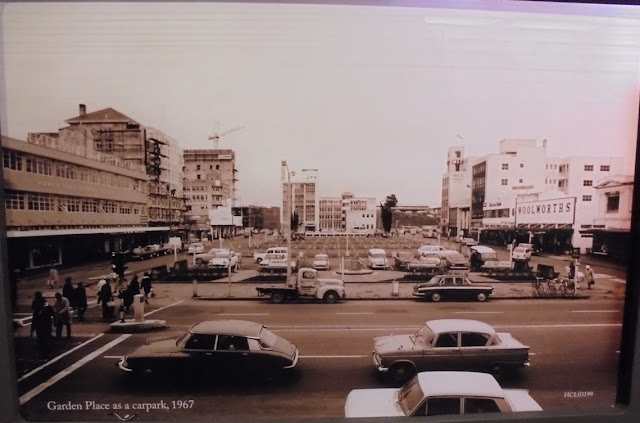Above is how the Orange Coronation Hall looked back in 2006. Previous blog post here.
Yesterday -- this is the new Orange. Tony Smith of Burwood Orange Ltd contacted me in May this year, and invited me to take a look around what his company have done to the old Auckland landmark. With Tony, and another blogger from NZ Jazz, I was given a chance to see inside the building, and what the company have done to both change and restore it.
The development, by Crosson Clarke Carnachan Architects & Tonkin Zulaika Greer Architects in association, and Dave Pearson Architects, has received a heritage architecture award. The citation read: "It was a wise decision to retain the Orange Coronation Hall and make it the centrepiece of this new development: it has given the old building new potential, reduced the dominance of the new structure. The new, mixed-use building and ground-level public spaces flow around the hall at a respectful distance. Further consideration and respect of the past can be seen in gentle interventions – including steel windows and doors that bring light and open up to a new raised courtyard – that ensure traces of the hall’s former use remain. All that is missing now are tenants. When they arrive, the potential of the hall and adjoining spaces is sure to be fully realised."
The development, by Crosson Clarke Carnachan Architects & Tonkin Zulaika Greer Architects in association, and Dave Pearson Architects, has received a heritage architecture award. The citation read: "It was a wise decision to retain the Orange Coronation Hall and make it the centrepiece of this new development: it has given the old building new potential, reduced the dominance of the new structure. The new, mixed-use building and ground-level public spaces flow around the hall at a respectful distance. Further consideration and respect of the past can be seen in gentle interventions – including steel windows and doors that bring light and open up to a new raised courtyard – that ensure traces of the hall’s former use remain. All that is missing now are tenants. When they arrive, the potential of the hall and adjoining spaces is sure to be fully realised."
The view across Newton Road to St Benedict's Street from the courtyard, freed up by the removal of a 1930s annexe formerly attached to the dance hall area.
I thought, while looking up at the courtyard from the road, that someone had left some chairs outside. But -- these are actually bolted-down art installations, harking back on dance hall seats. A funky touch.
Just as cool -- this orange planter, keeping up the theme.
And an extra touch -- dance steps by the planter, exterior doors ... if you didn't know this was the famous Orange, slick-as and made for dancing, you soon will do.
The developers and architects have worked hard to keep as many original features as possible. The ticket office window here ...
... and the 1950s sprung flooring in the main hall. The removal of the annexe allows for more natural light to come in, and an indoor-outdoor feel, which (with a planned cafe on the site) will add to people's mobility around the complex.
We even had a look at the Orange Lodge meeting room upstairs, complete with doors still with their "Who's there?" openings.
The developers have made every effort to retain features such as doors and windows. Some have had to go, of course, and there was earthquake strengthening to consider, but overall -- the Orange still has a feel to it that harks back to its days as part of Auckland's popular cultural scene.
Overall -- I like what they've done to the grand old lady, 100 years old come 2022. Normally, I don't like the modern trend of mix-and-match when it comes to heritage features and modern spaces -- but this has both preserved and restored the Orange Coronation Hall, and adapted it for survival into a second century. My sincere thanks to Tony Smith for the opportunity to take a look.






















